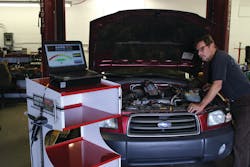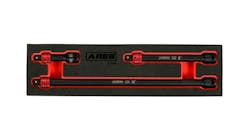CUSTOMER CONCERN:
Low idle, possible P0121 and P0507, P2004 and no performance faults.
VEHICLE APPLICATIONS:
2007 Chevy Suburban 5.3L, 2000 GMC Safari 4.3, 2009 VW Jetta, 2000 Toyota Camry 2.2L.
Tests/Procedures, specifically for a 2007 Chevy Suburban 5.3L with a P0121:
Summarized diagnostic steps provided from TSB PIP4578 courtesy of AllData.
- After a throttle body-related repair, with a scan tool perform a "reset idle learn/idle learn reset" procedure to erase/reset the learned throttle angle.
- If the DTC and/or related symptoms does not go away, do a "soft reset" to erase the PCM's memory and update its Calibration ID if possible.
- If the throttle body has been replaced and the module has been updated, and there is still a problem, replace the PCM.
TOOLS USED:
- J2534 pass-thru device
- Fuel system cleaning equipment
- Fuel injector bench-tester and ultrasonic cleaner
- Scan tool
- Carbon build-up analyzer
Carbon build-up is an invisible boogeyman in automotive repair. It gradually saps performance, creates pinging and causes low idle issues.
Many shops have become involved in the profitable field of fuel system cleaning as preventative maintenance. Some shops find this hard to sell, because it is hard to prove to a customer that a vehicle "needs it." Brand new tools have changed this.
Furthermore, repairing carbon-related issues is serious business as well. Different tools assist the technician in diagnosing component failures, cleaning intakes, flow testing injectors and much more.
Upsell customers on fuel system cleanings
In the old days customers had to take the technician's "word for it" if an engine needed a "decarb." This all changed with the invention of the borescope. All the technician had to do was remove a spark plug, put the borescope down the hole and show the customer that there was carbon. With the invention of color borescopes and SD cards, it has become easier than ever to use this technique. (See Fig. 1.)
However, with the increasing amount of covers, use of coil-on-plug ignition and hard to remove spark plugs (such as on Fords), the time needed to use this "upsell" technique has grown exponentially. At the same time, with the increase of direct fuel injection systems that create an increasing amount of carbon buildup, the need for fuel system cleaning has also increased.
Thanks to new technology, carbon build up can be detected without taking anything apart on the vehicle. At the cutting edge of carbon buildup detection is the Combustion Performance Tool (CPT) developed by Thompson Automotive Labs, and the AutoEKG, developed by Automotive Test Solutions and exclusively available for lease from ITW Professional Automotive Products.
The tools perform fundamentally the same task, but work a little bit differently. Both tools use a pressure transducer in the exhaust pipe (Figs. 2A and 2B) that measures irregularities in exhaust pulses in order to detect carbon buildup. The AutoEKG also uses an antenna on top of the engine to assist in its calculations. The computers in these tools then determine how bad the carbon buildup is in a vehicle, using a 1 to 10 scale.
Tools like these offer shops the ability to upsell vehicles on fuel system cleanings without a lot of investment in time and they will grow ever more important as vehicles move to higher compression ratios, and have less profitable maintenance and serviceable items.
2007 Chevy Suburban 5.3L, low idle and P0121
A lot of GMs with 5.3L motors have throttle bodies going bad from carbon build up. Usually this results in rough running, hard starts and a P0121 DTC.
The cause is excessive carbon buildup at the throttle plate (Fig. 3,) holding the throttle plate open. These electronic throttle bodies with the proper precautions can be cleaned properly and have the throttle position relearned, but let it be noted that many dealers simply replace the part. Nonetheless, if the throttle body isn't cleaned soon enough, the vehicle will not relearn throttle position and the throttle body will need to be replaced, regardless.
As per TSB PIP4578 (Fig. 4,) when replacing the throttle body because of a P0121, perhaps in conjunction with a P0507, use your OEM enhanced scan tool to relearn idle. If it doesn't work, simply do a soft reset of the vehicle and reflash the PCM to the latest calibration ID. For whatever reason if the codes and symptoms still do not disappear, the OEM recommends replacing the PCM and reflashing it.
2000 GMC Safari misfire
Using Mode 6, or here a misfire counter on the Bosch Tech2 (Fig. 5,) we can count cylinder misfires. Using OEM enhanced bidirectional controls, a fuel injector power balance test can be done. The result of the test was that the misfire was related to the poppet-style fuel injectors. The issue was corrected by running a fuel injector-specific cleaner through the fuel rail. (See Fig. 6.)
It is recommended that if the misfires return to simply replace all the fuel injectors.
2009 VW Jetta 2.0L P2004, no symptoms
Volkswagens with direct fuel injection have major carbon build up issues in their intake manifolds due to the high compression in the engine. It is recommended to either do periodic intake cleanings with a fuel system cleaner tool or consign the vehicle to having a symptom-less P2004 Intake Manifold Runner Stuck Open DTC. (See Fig. 7.) If this DTC occurs, the intake manifold can no longer be cleaned. Instead, it will have to be replaced.
2000 Toyota Camry 2.2L running lean
Lastly, a vehicle that runs rich at idle, but not under load typically has dripping fuel injectors. However, a speed density system, like a 2.2L Toyota, works the opposite way. All the systems on the vehicle checked out, but there was no way to verify whether the fuel injectors were responsible. Even though a HC per cylinder test with an emissions analyzer might find something, the only way to know for sure is to test the fuel injectors on a "bench." Here, the Launch X-SonicClean does a sprayability test, which shows the injectors spraying at different levels and that the far left injector is dripping. (See Fig. 8.) The repair to this issue is to ultrasonically clean the fuel injectors.


